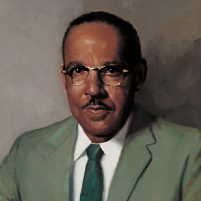 Dixie Place, the city street that runs between Vanderbilt University Medical Center’s Central Garage and the Oxford House on 21st Avenue South, has been renamed Vivien Thomas Way.
Dixie Place, the city street that runs between Vanderbilt University Medical Center’s Central Garage and the Oxford House on 21st Avenue South, has been renamed Vivien Thomas Way.
A Nashville native, Thomas grew up in the Jim Crow South and enrolled as a premedical student at Tennessee Agricultural and Industrial College, a historically Black college in Nashville, but was forced to drop out due to the Great Depression and was never able to enroll in medical school. He secured a job as a laboratory assistant in 1930 with Dr. Alfred Blalock at Vanderbilt University; was tutored in anatomy and physiology by Blalock and his research fellow, Dr. Joseph Beard; and rapidly mastered complex surgical techniques and research methodology. Due to the institutional racism at the time, Thomas was classified and paid as a janitor despite the fact that by the mid-1930s, he was doing the work of a postdoctoral researcher in Blalock’s lab.
Thomas later developed and refined a corrective cardiac surgical technique to treat “blue baby syndrome” at The Johns Hopkins Hospital in the 1940s. Despite conducting years of lab work to demonstrate that the procedure could be performed safely on a human patient, Thomas did not receive due credit for the lifesaving advance — known as the Blalock-Taussig shunt — for decades.
Thomas died of pancreatic cancer in 1985.
André L. Churchwell, vice chancellor for equity, diversity, and inclusion and chief diversity officer for Vanderbilt University, stated that “Vivien Thomas was an individual who, despite institutional racism, made invaluable contributions to medical research that saved thousands of lives and advanced the field of cardiac surgery. The previous street name evoked a painful history in our country — one that is in stark contrast to Vanderbilt University’s vision for the future and efforts to foster an inclusive environment for our Black community.”












Something the Lord Made was a movie about Vivien Thomas. It was quite good